|
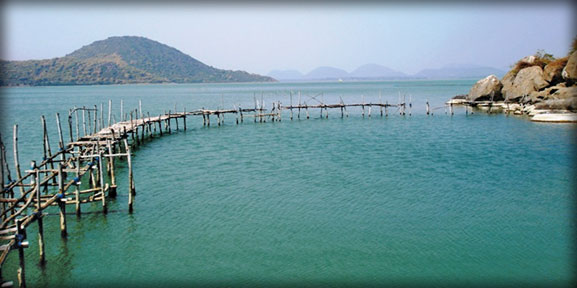
Chilika Lake |
The pendant in the Orissa necklace
by Amal Udawatta
The Chilika Lake is like a beautiful pendent attached to the Orissa
necklace which is on the coastline on the east coast of India. It is a
large brackish water wetland of Asia. It spreads across an expanse of
1165 km. During the rainy season it spreads across 906 sq km: in the dry
season it is nestled in the heart of coastal Orissa. It extends from
Bhusandpur in the Puri district in the north to the Ranbha-Malandin
Ganjan district in the south. Separated from the Bay of Bengal by a 60
km long narrow strip of marshy island and flat sand. It is the largest
wintering ground for migratory birds on the Indian sub continent.
The lake is home to a number of threatened species of plants and
animals. There is an ecosystem with large fishery resources. It sustains
more than 150,000 fisher folk living in 132 villages the shore and
islands.
The lagoon hosts 160 species of birds in the peak migratory season.
Birds from as far as the Caspian sea, Lake Bikal, Aral sea and other
remote parts of Russia. Kirgaiz steppes of Mongolia,Central and
Southeast Asia, Ladakh and the Himalayan region come here. These birds
travel great distances; migratory birds probably follow much longer
routes possibly up to 12,000 km to reach the Chilika Lake.
|
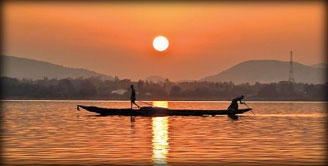
Sunset on Chilika Lake |
According to a survey, 45percent of the birds are terrestrial in
nature, 32 percent are waterfowl and 23 percent are waders. The lagoon
is also home to 14 types of raptors. Around 135 rare and endangered
Irrawaddy Dolphin have also been reported. The lagoon supports about 37
species of reptiles and amphibians.
The open air and scenic natural fauna and flora of the lake are an
attraction for eco tourism. this is expected to provide a degree of
alternate employment to the local community and generate environmental
awareness among the local residents as well as visitors, about the
conservation and wise use of the lake's natural resources.
The location within the lake identified for such activity. Some of
prominent islands like Nalabana, Kalijal, Solomo, Honeymoon, Break Fast,
Birds island, and Rajahansa situated in the southern end of the lake.
It is a popular tourist site with a number of island and a vast
stretch of blue water. The Kalijai Temple located on one of the islands
is considered to be the abode of the goddess Kalijai.
This temple is on a hill surrounded by blue water bears. The locals
of Chilika refer to the goddess as the reigning deity of the lagoon.
Biodiversity
The ecological richness is of great value in preserving the habitat.
A survey on the lake between 1985 and 1988 has identified 800 species of
fauna and flora,including many rare endangered, threatened and
vulnerable species.
The rare and threatened animal species identified are green sea
turtle (Chelonia mydas) (EN)Dugong (Dugong dugong) (EN) Irrawaddy
dolphin (Orcaella brevirostris) (VU), Black duck (Anas rubripes) (NT)
Spoon billed sand (Eurynorhynchus pygmeus) (CR) and Fishing
cat(Prionailurus viverrinus) (EN). 24 species of mammals were reported
37 species of reptiles, and amphibians are reported.
Recent surveys revealed an overall 726 species of flowering plants
belonging 496 genera and 120 families.
|
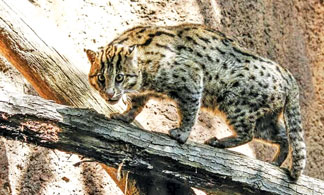
Sunset on Chilika Lake |
|
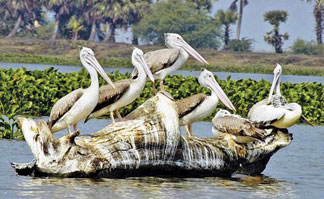
Pelicans at Bird's Island, Chilika |
|
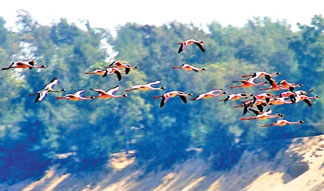
Lesser Flamingos |
This represents about one - fourth of vascular plants species of the
Orissa state. were some 2900 species altogether are found. The kk
Fabaceae is the most dominant plant family followed by Poaceae, and
Cyperaceae.
The flora is predominantly aquatic and sub aquatic.
Avifauna
This Lake is the largest wintering ground for migratory birds, on the
Indian sub continent.
It is one of the hotspots of biodiversity in the country. Some
species listed in IUCN Red List of threatened animals inhabit the lake
for at least a part of their life cycle. White bellied sea eagles, Grey
lag geese, purple moorhen, Jacana, herons Flamingos, egrats, White ibis,
Spoonbills and more. Migratory water fowl arrive here from as far as the
Caspian sea, Bikal lake, and remote parts of Russia, Mongolia, Siberia
Iran, Afghanistan and from the Himalayas.
The Chilika Development Authorty (CDA) updated data (Year 2002) 323
aquatic species, which includes 261 fish species, 28 prawns, 34 crabs,
are reported out of which 65 species breed in the lake. Six threatened
species also live in the lake including Milk Fish, Indo Pacific tarpon,
Ten pounder, Bream, Hilsa and Mullet. Irrawaddy Dolphin (Orcaella
brevirostris )is the flagship species of Chilika Lake. Chilika is home
to the only known population of Irrawaddy dolphin in India and one of
only two lagoons in the world that are home to this species. A small
population of Bottle Nosed Dolphin also migrate into the lagoon from the
sea.
The Butter Catfish are the most common type of fish found in the
lake.
Geological studies indicate that the coastline along the western
shores of the lake belong to the Pleistocene era with its northeastern
region. lying under the sea.
That the coastline has moved eastward over the ages is supported by
the fact that the nearby Konarak Sun Temple. It was built originally on
the seashore, a few hundred years ago. It is now about 3km away from the
coast.
The catchment area of Chilika Lake has a rock and sand substratum. It
contains a wide range of sedimentary particles such as clay, silt, sand,
gravel and shell but the major part of the catchment area is silt.
Around 1.6 million metric tons per year of sediment is deposited in
Chilika by the Daya river and several streams.
Chilika is a shallow bar-built estuary with an area of flat mud.
Several inland rivers bring silt in to the lake.
The lake has numerous islands. The larger islands are separated by
shallow channels. The six major islands are Parikud, Phulbari Beralpura,
Nuapara, Nalabana, and Tempera. These islands and the peninsula of Malud
make up the land areas of Chilika.
The water depth varies from 0.3 meters in the dry season to 1. meters
in the rainy season.
The width of the old channel to the sea is now reported to be about
100 metres and is known as Magarmukha. (Mouth of the Crocodile) The lake
is divided into four separate zones During the summer, the intrusion of
salt water from the outer channel into the lake increases since water
level to the lake is at its lowest lavel.
A general increases in salinity of the central and northern zones
occurs due to wind induced mixing by the predominantly southern winds
and the salinity in the southern zone dose not rise appreciably.
The lake is vaguely pear shaped and maximum length 64.3 km with a
mean width of 20.1 km. The hydrological sub system control the Hydrology
of the lake.
The land base system comprises tributaries of the Mahanadhi river on
the north side, 52 river channels from the western side and the Bay of
Bengal on the eastern side.
Breakfast island
|
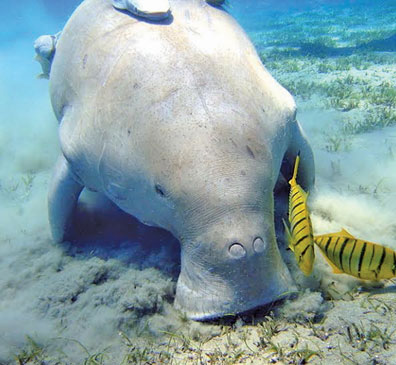
Dugong |
This island is in the Rambah Bay and between Badakuda and Solomo
island.It is the pear-shaped Casupourea ceylanica, a mangrove associate.
Honeymoon island
It is situated in the Rambah bay near the Sanakuda island. It is five
km away from Rambah jetty. It is also known as Barkando island. The
water around the island is clear The limbless lizard was found on this
island. The Somolo island is situated in the central and southern sector
of the lake. These islands are inundated remnants of the Eastern Ghats.
Though rocky they are rich in flora and fauna. Dolphins are often
sighted on the peripheral water of Solomo island.
A beautiful and unique backdrop to Solomo is the Khallikote hill
range.
Birds island is situated in the southern sector of the Chilika Lake.
This is a small hillock with huge exposed hanging rocks.
The granite rocks are also said to be the remnants of the Eastern
Ghats.
Some rocks are painted white with the dropping of birds.
Some local birds used the island as perching ground during the winter
season. Migratory birds are sighted here in large numbers. It is
well-known for its rich algal communities.
Nalabana Island
The large Nalabana Island covering about 16 sq km in the lagoon area
was declared a bird sanctuary in 1987.
The core area of about nine sq km attracts around 400,000 water fowls
of different species. |

